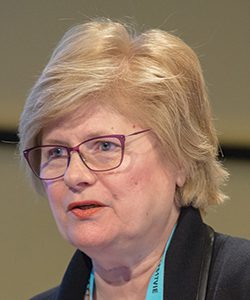Member Article
Variations of Loneliness Include Implicit Anti-Black Bias
When picturing someone “lonely,” you might imagine a solitary figure walking down a dark street at night or someone sitting at home with nowhere to go and no one to see. We often equate loneliness with being alone, but it’s just as much an emotion as a physical state.
Four scientists discussed what author Janet Fitch calls “the human condition,” including its origins, varieties, and consequences, at the 2017 International Convention of Psychological Science in Vienna, Austria.

Stacey Sinclair says a phenomenon called “implicit homophily” may foster problematic social interactions whereby individuals from minority groups, and even their White friends, are excluded from certain situations.
APS Board Member Stacey Sinclair, an experimental social psychologist at Princeton University, and her collaborator, Drew Jacoby-Senghor at the Haas School of Business, University of California, Berkeley, study a unique basis of social exclusion among Whites: implicit anti-Black bias. This phenomenon, called “implicit homophily,” may foster problematic social interactions whereby individuals from minority groups, and even their White friends, are excluded from certain situations. Sinclair noted that forging interpersonal connections is linked with positive mental and physical health outcomes. And, she argued, “a central way we achieve this connection is by being drawn to people who are similar to us.”
To examine this idea, Sinclair, Jacoby-Senghor, and colleagues conducted a set of online experiments using Mechanical Turk to see whether White participants’ implicit bias would affect how they reacted to other Whites who were friends with Blacks.
They asked study participants to complete two Implicit Association Tests (IATs) designed to measure anti-Black bias. Afterward, they assigned each person to rate how much they liked a White person in photos of a White person paired with a person of varying ethnicity, always of the same gender. Individuals were told they were rating either a friend of or a stranger to the White person. The result: The higher participants scored on the anti-Black bias IATs, the less they liked a White person who had a Black friend — however, participants had no negative opinions when they believed they were rating individuals who did not know each other.
Because people also communicate their social preferences through nonverbal means, the research team designed another study to determine whether such nonverbal behaviors affected anti-Black bias. Participants again completed IATs, and then watched videos of a White person interacting with either another White person or with a Black person. In some videos, the White person displayed body language signaling ease; in others, the White person was visibly uncomfortable. Participants rated how much they liked the White person in each interaction.
Sinclair and her colleagues found that the more implicit anti-Black bias a participant had based on the IAT, the less they liked a White person who appeared to be comfortable interacting with a Black person. They found no effect of implicit bias, however, for the uncomfortable condition; the raters disliked all situations in which the White person appeared uncomfortable.
The research team wanted to see if these results would hold up outside their virtual lab, so they asked the college students who had completed the IAT for permission to examine their Facebook profiles and delve into their social networks. They examined the top 10 friends of each student, as well as the top 10 friends of those individuals. Sinclair and her colleagues found that White females with higher implicit bias scores were less likely to be friends with White people who had Black friends compared with those who scored low on implicit bias. For men, however, there was no relationship between implicit bias and social connections. Some research on friendships, Sinclair said, would seem to support this, suggesting that women’s friendships are based primarily on similarities such as face-to-face talking and sharing values, whereas men’s are focused more on shared activities.
“This desire to connect with others, which leads us to gravitate toward people who are similar, is a means by which we get homophily in our social networks,” she concluded. “It’s not only demographics of homophily — this suggests the possibility of ideological homophily as well … on this dimension that you aren’t even able to articulate that you have.”

Frosso Motti-Stefanidi is leading a longitudinal study of more than 2,000 immigrant adolescents in Greece, with the aim of identifying factors that put migrant youth at risk for exclusion in classroom settings.
APS Fellow Frosso Motti-Stefanidi of the National and Kapodistrian University of Athens hopes her research can inform policymaking in her home country of Greece. In particular, her work seeks to identify the factors that put migrant youth at risk for exclusion in classroom settings.
Motti-Stefanidi and her research group are conducting a longitudinal project, the Athena Studies of Resilient Adaptation (AStRA), which includes two cohorts totaling more than 2,000 immigrant adolescents and their nonimmigrant classmates. The psychological scientists follow these children across their 3 years of middle school, from ages 12 through 15. One of the advantages of the project, said Motti-Stefanidi, is that the team started collecting data before Greek economic crisis began and continued through the crisis (the first wave was conducted from 2005 through 2007; the second from 2013 through 2015).
For migrant youth, the school is an acculturative arena, Motti-Stefanidi said, so it is particularly important that they feel included: “This is where youth are exposed to the host culture, so being accepted by their nonimmigrant and immigrant peers may have consequences for youths’ sense of belonging and adjustment in school. Discrimination and rejection, on the other hand, has negative consequences for acculturation, for well-being, and for adaptation.”
To determine the factors that help or hinder migrant youths’ ability to adjust to their new country, Motti-Stefanidi and her colleagues used AStRA to examine three groups of immigrants — Albanian, Pontian Greeks from the former Soviet Union, and other ethnic groups not included in the former two categories — and their relations with peers within classrooms.
“How well relations are formed and how well they’re developed is consequential for youth adaptation and well-being,” Motti-Stefanidi explained. “If you feel rejected, friendless, or victimized, this makes school a less-than-desirable context, and in such cases, the school may become a place that is unlikely to promote learning and well-being.”
In one study, the psychological scientists investigated acceptance and rejection of immigrant youth by nonimmigrant peers. Using a social metric technique, they asked all students to write down the names of the three peers they liked most and the three they liked least.
Results showed that immigrants in classrooms with equal numbers of immigrants and nonimmigrants were less accepted by their classmates than those in classrooms with higher percentages of immigrants; when immigrants comprised 66% or more of a class, they were more accepted by classmates than were Greeks. Over time, immigrant students in classrooms with few immigrants became increasingly accepted by their Greek peers.
The researchers also found that at first contact, immigrants were more rejected than Greeks. Over time, however, immigrants were significantly less rejected by their peers, and were actually rejected only as often as their Greek counterparts. These results show, said Motti-Stefanidi, that “increasing familiarity through intergroup contact with immigrant classmates decreased, over time, the prejudice of Greek students.”
Motti-Stefanidi conducted a second study examining the “crisis cohort” of students who were in middle school from 2013 through 2015. Using data from teachers, school records, and self-reports, she and her team looked at how peer acceptance of immigrant and nonimmigrant students by Greeks and immigrants related to self-esteem and depression.
They found that, while Greek students’ well-being did not vary according to whether their classmates accepted them, immigrants’ self-esteem and depression levels were more affected by Greek students’ opinions than by those of fellow immigrants. Interestingly, however, this was only true for Greek majority classrooms. “The moment [ethnic] heterogeneity increases, this effect falls apart,” Motti-Stefanidi said. “Thus, effects of peer pressure on self-esteem and depression were found only in ethnically more homogenous classrooms, and only for [immigrant] preference by Greeks.”
The outcomes of these two studies, she added, “produce a double-edged sword: Classrooms with high immigrant composition may promote positive development … however, at the same time, they work against immigrant youth acculturation, because you don’t have enough exposure to the host culture. In contrast, classrooms with low immigrant composition may promote positive acculturation but present a risk for immigrants’ development and psychological well-being.”
It is up to educational leaders such as teachers and principals, therefore, to design classrooms that strike a balance between promoting immigrant self-esteem and acculturation, as well as taking into account the needs of Greek students, Motti-Stefanidi concluded.

Taciano L. Milfont believes longitudinal studies, such as the 20-year New Zealand Attitudes and Values Study, are essential to developing a typography of loneliness.
Taciano L. Milfont, Victoria University of Wellington, New Zealand, hopes to create a new typology of loneliness by examining the kinds of people who are likeliest to feel lonesome.
“Researchers have argued that loneliness is a perception of social relationships as deficient or unsatisfying,” he explained. “So feeling lonely is distinct from the objective reality of being alone. You might be among a lot of people, and loving people, but you still feel loneliness.”
To tease out the types of loneliness that might exist in the New Zealand population, Milfont and colleagues analyzed data from more than 18,000 participants in the New Zealand Attitudes and Values Study (NZAVS), a 20-year nationwide survey led by Chris Sibley of the University of Auckland. As part of the study, participants rated the veracity of three statements designed to assess how much they felt accepted and cared for: “I know that people in my life value and accept me,” “I feel like an outsider,” and “I know that people around me share my values and beliefs.” The study was led by clinical psychologist Hannah Hawkins-Elder and also included social psychologist Matt Hammond.
From these data, the psychological scientists identified four distinct loneliness categories: High loneliness, low loneliness, “appreciated outsiders” (e.g., those who found appreciation in close personal relationships because they were valued and accepted despite feeling like outsiders in general), and “superficially included” (e.g., those who didn’t feel like outsiders but also didn’t feel valued and accepted by others in meaningful ways).
The results showed that people in the high-loneliness category had the lowest levels of well-being of the four groups. This falls in line with previous studies that have linked loneliness with severe physical health problems — such as nausea and headaches, poor sleep, increased alcohol consumption, and increased likelihood of smoking — and mental health problems, such as depression and anxiety. These consequences can create a negative feedback loop, Milfont says, leading people who are already feeling isolated to sink deeper into loneliness. If a person is already feeling tired or depressed, for example, they may be unlikely to make an effort to connect with others. Longitudinal studies like the NZAVS, he argues, can help illuminate this link.
Interestingly, appreciated outsiders scored almost as high as did the nonlonely on measures of well-being. This suggests, Milfont said, that it is better to have a few close relationships than many surface-level ones. It also may explain why people who already feel lonely tend to have negative experiences with social media, which often fosters casual connections rather than deep or meaningful relationships.
Indeed, other researchers have used NZAVS data to examine the interplay between loneliness and social media usage over time. Their findings suggest that participants’ Facebook habits were not uniformly negative or positive — rather, the relationship between Facebook use and loneliness over time seemed to depend on individual personality traits.
Milfont hopes this ongoing line of research will help the government of New Zealand better understand social exclusion and develop new interventions for loneliness. The study is now in press at the Australian and New Zealand Journal of Psychiatry.

Drawing from data gleaned across 10 years, Alan Teo has found that the quality of people’s social relationships is the factor most strongly linked with depression.
Alan Teo, US Department of Veterans Affairs and Oregon Health & Science University, studies the implications that social connections have for clinical issues, focusing specifically on depression and suicide prevention. Teo’s interest has a personal origin: When he began working in this field, he treated a young man who had been in extreme withdrawal from the outside world for several years and who lacked even rudimentary social connections. Through their interactions, Teo realized that “we really need primary prevention strategies, particularly for conditions like depression.”
Teo, like Milfont and Motti-Stefanidi, advocated using longitudinal data to track individuals’ behavioral development across extensive periods of time. For one study, Teo drew on Midlife in the United States, a nationally representative sample of American adults, to determine how social relationships correlate with individuals’ chances of developing depression.
The scientist and colleagues identified those participants whose quality and quantity of social relationships were measured in the 1990s and looked at the 10-year follow-up survey to see who had developed depression. Not only did they find a connection between social connections and depression, they established that the quality of people’s social relationships was actually the factor most strongly linked with depression development, even across a time span of 10 years.
Echoing Milfont, Teo emphasized that it is the quality of prosocial relationships that boosts individuals’ well-being, not their frequency of contact or number of friends. In fact, the data indicated that negative social connections increased people’s absolute risk for depression, raising it from 7% to 14%.
In a second study, Teo explored how different modes of social interaction — virtual or electronic contact versus face-to-face conversation — affected the risk of developing depression among older adults. Examining data from the Health and Retirement Survey (2004–2010) for adults aged 50 and above, he and colleagues discovered that in-person contact was the only clear predictor of mental well-being. The findings indicate that such in-person contact may provide a buffer that counteracts the risk of developing depression.
In addition, supportive family and friends can act as “gatekeepers” who help connect a person with formal mental health services in times of need. This role is not without challenges, however, Teo noted.
“It’s not a God-given skill to be a good gatekeeper,” he explained. “It doesn’t matter how good of a friend you are; if I put you on the spot right now and said, ‘Imagine you bumped into a friend today and they seemed to be in crisis: What would you do?’ It’s easy to say that we might do this and that, but again, when we’re actually put in a real-life situation, it’s a lot harder.”
Fortunately, gatekeeping is a skill that can be fostered, the scientist said. In a study in which he partnered with a specialty clinic for Japanese patients at the University of Michigan, Teo and colleagues provided two community events designed to encourage participants to seek and promote mental-health-care services. The first event was a multimodal intervention with a film screening, gatekeeper training, and an expert panel; the second involved only a lecture on a related topic and an expert panel.
The results were clear: The event with the gatekeeper training significantly improved people’s intended gatekeeper behavior, while the other did not. Teo clarified that this does not necessarily mean individuals followed through on their gatekeeping training, but said it was a positive sign nevertheless.
“One of our challenges,” Teo closed, “is, how can we have mental health interventions that work within our natural social network — those close relationships that do seem to matter for depression, suicide, and other things?”




